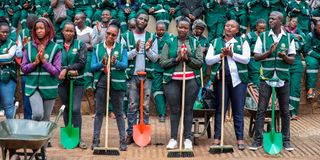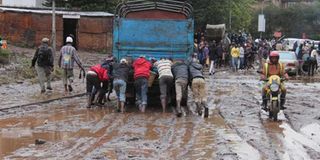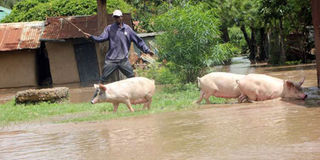Premium
Villagers living in fear as El Niño peril looms large

A boda boda operator ferries his passenger amid heavy rains in Eldoret, Uasin Gishu County, on September 25, 2023. The Meteorological Department has announced that El Nino rains may fall countrywide.
River Ngong snakes past Gatoto village in Mukuru Kwa Reuben, dragging in its wake raw sewage, discarded plastic, and sundry debris.
During rainy seasons, it often turns into a monster, carrying away people and their property.
Over 20 families call this nightmarish place their home, condemned to witness this heartbreaking spectacle in their own backyards. Their windows remain locked tight, as if trying to keep out not only the stench but also the anguish that permeates their existence.
Rancid smell
Their mealtimes and slumbers are accompanied by the rancid smell that seeps through the cracks in their fragile walls.
When the heavens open up, the river's hunger intensifies, swallowing even more filth and rising with an unkind intent. It hurls its vile contents into the homes of these resilient residents, as if mocking their struggle for a semblance of normalcy.
Ms Lena Sitawa, residing on the river's edge with her one-year-old child, has grown accustomed to remaining vigilant during rainy nights, anxiously awaiting any sign of danger.
“We can't sleep when it rains, and at night, we get calls telling us to run for our lives. We need the government's help,” she says.
Mr Fred Nyambane vividly remembers the harrowing nights when he used to reside in Mombasa, forced to evacuate his home due to severe flooding.
With only a week left before the anticipated onset of the El Niño rains, Mr Nyambane and his wife have already made careful arrangements to shield their two precious children from the cold and potential hazards that may accompany this impending weather phenomenon.

Some of the youths employed by Nairobi County to take part in El Niño preparedness at Uhuru Park Nairobi on September 11, 2023.
“We heard in the morning news that El Nino is due in October. I asked my wife to check our savings for some money so that we could visit Gikomba to shop for warm clothing for the children. We do not want them to catch pneumonia. My eldest child schools nearby, and usually cross a bridge on his way to school. We have agreed that when the rains begin we will have to take him to school each morning, using a longer but safe route,” he explains.
“We have also installed mosquito nets to keep them safe from mosquitoes. We are also going to ensure that we buy food that lasts a couple of days so that we avoid going out frequently,” he adds.
However, Ms Susan Naliaka, who has a young school going child and a newborn due in October, hopes her husband has a plan to save them from the impacts of the El Nino rains.
“I am not really ready for what will happen. I will buy my children warm clothes to protect them from the cold, but I am worried that the river will spill its water into the house. I am told that some concrete pillars were erected, but I am not sure what is going to happen, especially since I’ll have two young children, one of them a newborn,” she says.

Good Samaritans help push a vehicle that was left by the owner in South C after roads were flooded following a heavy downpour on May 12, 2015.
Back in 1997, during the El Niño event, the government declared it a national disaster. The heavy rains and floods messed up water sources and wrecked water treatment plants, leading to diseases like cholera, typhoid, dysentery, and hepatitis spreading like wildfire.
Spread diseases
By July 1998, there were 472,528 cases of malaria with 2,705 deaths, and 44,833 cases of cholera with 2,525 deaths. In Wajir town, all 40,000 folks there were left without clean water or a toilet because the floods messed up their wells and washed away their bathrooms.
El Niño also made it easier for disease-carrying bugs like mosquitoes, flies, and snails to breed and spread diseases like malaria, Rift Valley fever, dengue fever, and schistosomiasis. More than 400 people died and many animals contracted Rift Valley fever.
Cut short
The mess didn't stop there. About 2,000 schools were submerged. Because of the rains, the school year was cut short by two weeks, but it varied depending on how bad the flooding was. Some schools opened up again after just two weeks, but others took months.
According to a report from Save the Children International, El Niño might bring heavy rains, flooding, and food shortages. This could mean children going hungry, getting sick, and lacking clean water, toilets, and healthcare.
“Children are more likely to be separated from their families in the chaos of a disaster or while seeking refuge. And when separated, they are at much higher risk of facing violence, abuse and exploitation. They are more likely to face poverty and child protection risks when their families’ livelihoods are destroyed by floods. It is their futures that are threatened when storms batter their schools, or they are forced to drop out of education due to drought-induced displacement,” the report says.
Emergency number
On September,11, Nairobi Governor Johnson Sakaja launched an El Niño preparedness plan for the city county, which included the establishment of an emergency number for stranded Nairobians to call for help.

A resident of Ombeyi Village in Ahero moves with his pigs to safer grounds on November 17, 2015 as heavy El Nino rains pounded the area. At least 200 families have been displaced in Ahero, Kisumu County after River Nyando burst its banks following the heavy rains in the area. PHOTO | TONNY OMONDI | NATION MEDIA GROUP
The county government also bought 1,200 wheelbarrows, six fire engines, five flushing units, five ambulances, eight excavators, four exhausters and 60 trucks to be used during emergencies.
It also mapped out unsafe buildings and made plans for the evacuation of residents.
Reporting sites
Borrowing lessons from the 1997 El Niño event, the country may need to increase the number of reporting sites, distribute drugs and supplies, conduct mass vaccinations and health education campaigns.
There is also a need to improve water supply and sanitation by repairing damaged infrastructure, promoting hygiene practices, monitoring water quality Providing food aid and relief to the affected populations.





